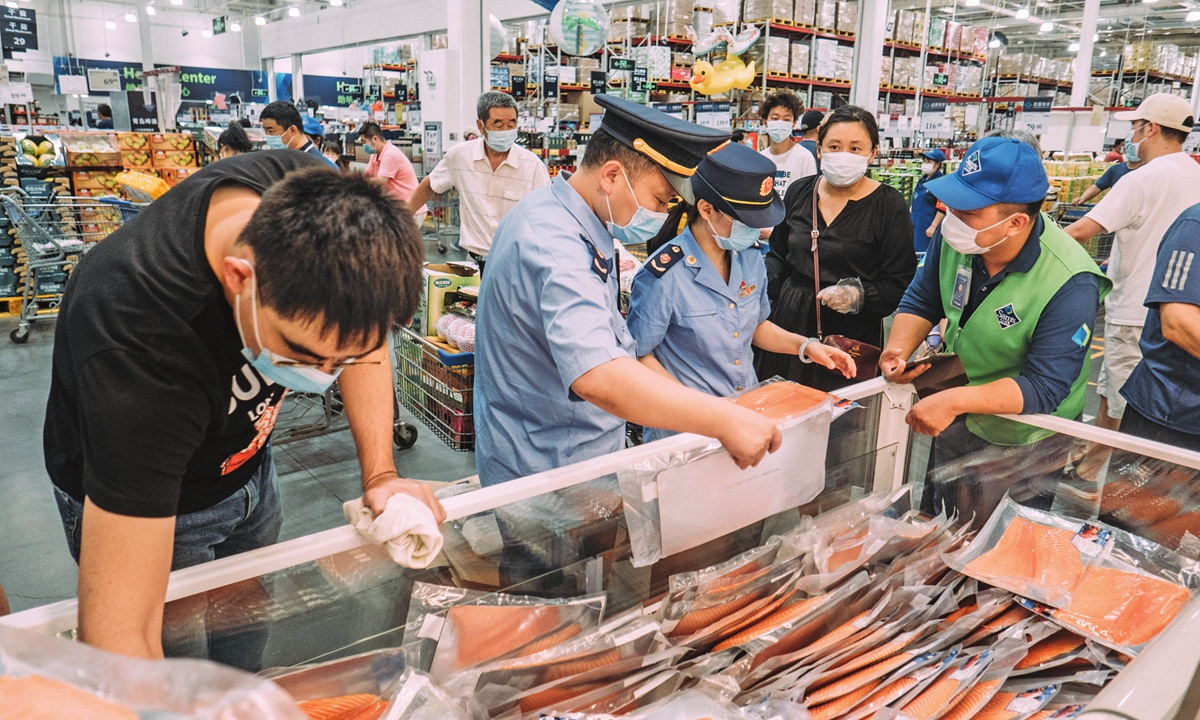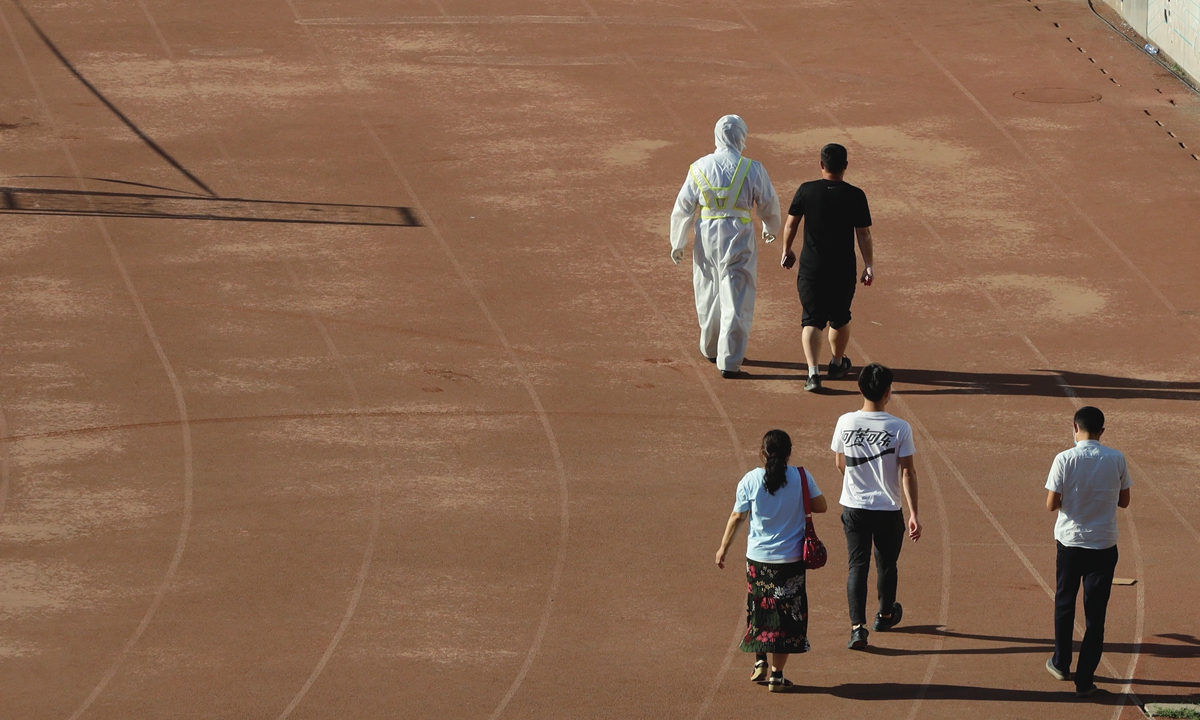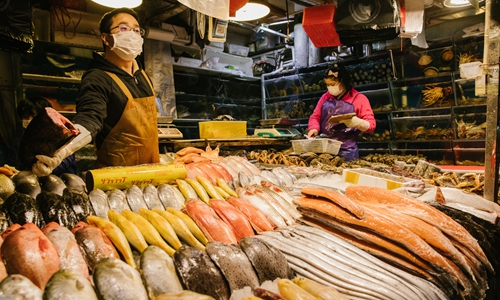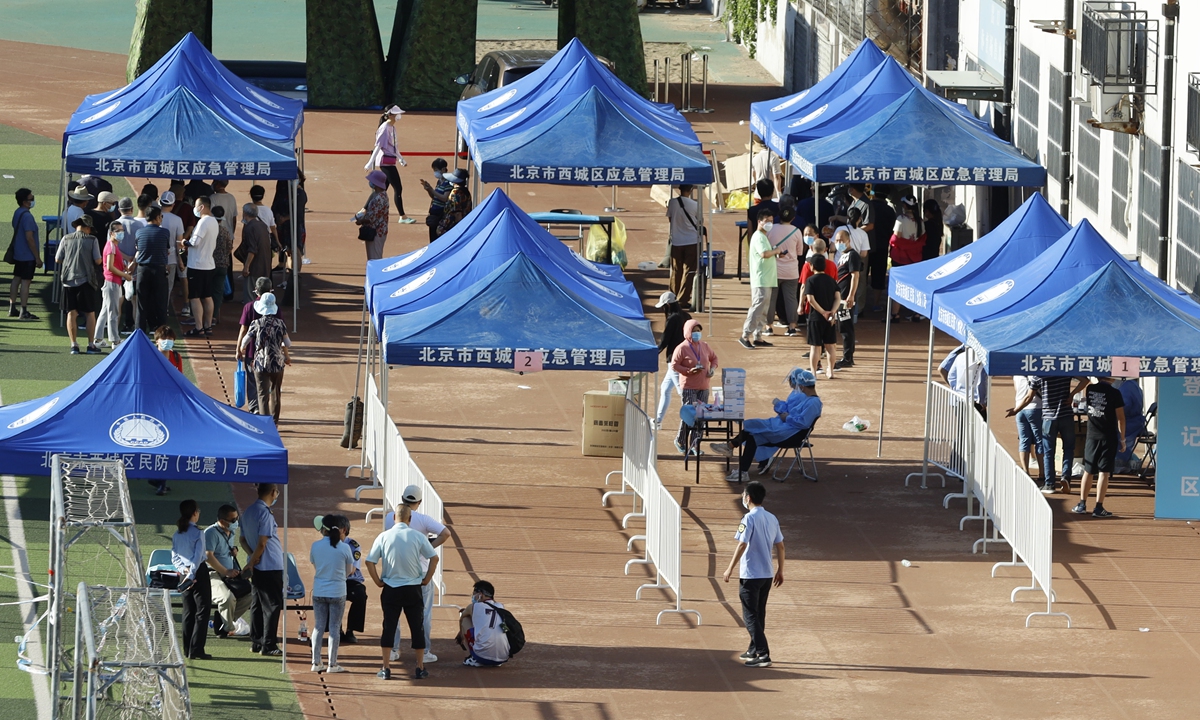
Food and Drug Administration employees check salmon in a Sam's Club store in Beijing on Saturday. Photo: Li Hao/GT
Major seafood markets in China have launched massive nucleic acid tests for their working staff and environmental samples as a quick response to the new COVID-19 outbreak in Beijing which was uncovered at the city's largest wholesale food market last week. Although there's no proof that salmon was the source of the sudden spike in Beijing, the latest research shows that the virus "came from Europe," and virologists believe the epidemic was most likely caused by contaminated food.
Several seafood traders reached by the Global Times on Monday said their packages are sealed at the local customs for nucleic acid tests, and they fear the losses from the spike would be "huge" as it is very difficult to store fresh produce, while requests to cancel or postpone their orders have risen.
Industrial insiders noted that the incident in Xinfadi market in southern Beijing's Fengtai district will have a huge impact on the imported seafood market across China and the world supply chain. However, given the authorities' competence in handling the matter, such an impact would be temporary.
They noted that the latest outbreak is also a reminder to major seafood exporters to China to strengthen their health quarantine and product quality.
Negative results
"Was the meat put on the shelves today? Where did they come from?" Market administration officials in Beijing's Haidian district launched a surprise inspection on one of the district's largest agricultural markets on Monday morning. The operations of the seafood stores in the market were suspended.
A senior official told the Beijing Daily that the district inspects food markets three days at a time. The market opens at 7 am every day and the district officials would inspect the suppliers' proof of delivery and quarantine measures at the previous night.
The official said fresh food, frozen pork, beef, mutton and other livestock and poultry are the key targets of the inspection. Food without a quarantine certificate or of unknown origin is strictly prohibited from the market.

Residents follow a health worker to a testing station at a sports center in Xicheng district after Beijing municipal government demanded all residents who visited the Xinfadi food market since May 30 to undergo nucleic acid tests for possible infection with the novel coronavirus after the city reported 51 confirmed COVID-19 cases as of Sunday. Photo: Li Hao/GT
Other districts in Beijing have also launched urgent tests at major supermarkets, cold storage warehouses and seafood restaurants, and all the results came back negative.
Cities including Wuhan in Hubei Province, Guangzhou, South China's Guangdong Province, Tianjin municipality, Chengdu in Southwest China's Sichuan Province, Ningbo in East China's Zhejiang Province also conducted nucleic acid tests on the wholesale market employees and environmental samples, especially salmon at seafood and frozen meat wholesale markets and restaurants. All these tests also came up negative.
Striking a blow
Many supermarkets and restaurants in China have taken salmon off their shelves and sealed them for further inspection.
A staff member of a large wholesale market in Shanghai's Pudong New Area told Global Times on Monday that because of the new outbreak in Beijing, they have upgraded epidemic control measures to the same level as when the outbreak took place in Shanghai in January. The market operators will check whether the products are from hard-hit COVID-19 areas, especially Xinfadi market, and whether seafood products like salmon are coming in.
The China Aquatic Products Processing and Marketing Alliance (CAPPMA) said that Russia, the US, Norway and Argentina are the top four seafood exporters to China. In 2019, Russia exported 1.7 million metric tons of seafood, with 70.5 percent going to China. Seafood exports from Norway to China are steadily rising. In 2019, Norway's exports reached 168,503 tons.

A seafood vendor solicits customers in Beijing's Sanyuanli Market in February. Photo: Li Hao/GT
Cui He, the president of the Alliance, told the Global Times on Monday that seafood exporters will be hit hard as imported salmon takes up to 85 percent of the domestic market, with 80,000-100,000 tons of salmon being imported every year.The world seafood supply chain will be further affected by the incident as China plays an important role in the global consumption of seafood, Cui said.
China has strict management and quarantine regulations on imported aquatic products, but novel coronavirus detection has not been included, news site yicai.com reported on Saturday, citing an employee from the General Administration of Customs. But the employee said it does not mean it will not add the test in the future.
Eason Li, the China general manager of Hofseth International, a Norway-based seafood producer, told the Global Times on Monday that Beijing Customs has stopped imports of all seafood products, while Shanghai has raised quarantine requirements for imported salmon. The company exported about 100,000 tons of salmon to China in 2019.
Beginning Saturday, each batch of imported salmon must undergo nucleic acid tests at the Shanghai Customs. The higher quarantine requirements would extend the shipping process by about one to two days, Li said.
Li said the losses would be great, as a delay of one to two days might cause the seafood to die without proper treatment. "Of our clients in China, customers who have not made final confirmations have asked to cancel their orders. For those who already placed the orders, some of them asked us to delay delivery," Li said.
A seafood insider told the Global Times on Monday that she got a statement from the Norwegian Seafood Council reminding the public that the Norwegian Food Safety Authority (NFSA) is clear that the coronavirus does not affect seafood safety, as there are no known cases of infections through contaminated food, imported food or water. Therefore, fish and seafood products from Norway are safe to eat.
The council said Norwegian salmon farmers are following strict measures to limit the spread of the COVID-19, and are managing their seafood production using strict hygiene and contamination measures.
The insider also shared a statement from Salmon Chile, which represents all Chilean salmon producers, to shares some measures that the salmon industry in Chile has been taking since the virus hit the country, as well as some hard facts over the virus and its interaction with seafood species in response to ease the Chinese public concerns.
Simon Brantes C, a business insider in exported products from Chile, told the Global Times on Monday that it has a significant impact on the supply chain. Instead of delivering foods to Beijing directly, the foods from Chile are now transported to other cities such as South China's Guangdong Province instead.
Europe as origin?
Yang Peng, an expert at the Beijing Center for Diseases Prevention and Control (Beijing CDC), told media on Sunday that the genome sequencing of the strain of the coronavirus which caused the new outbreak in Beijing shows it originated from Europe.
Preliminarily investigation shows that the virus found on samples from the Xinfadi market is related to strains China has seen from imported cases. The source of the virus is still being traced, and it is not known how it entered the market, Yang said.
Wu Zunyou, chief epidemiologist at the Chinese Center for Disease Control and Prevention, told the People's Daily on Monday that from the structure of the virus, the strain is unlike those found in Beijing two months ago. It is more likely from Europe.

Residents follow a health worker to a testing station at a sports center in Xicheng district after Beijing municipal government demanded all residents who visited the Xinfadi food market since May 30 to undergo nucleic acid tests for possible infection with the novel coronavirus after the city reported 51 confirmed COVID-19 cases as of Sunday. Photo: Li Hao/GT
"However, this does not mean the virus came from European countries. Analyses of the virus strain in the US showed most of them came from Europe, or from Russia. The preliminary results mean the virus in this new outbreak may have come from Europe, Russia, or North America. More information needs to be collected," Wu said.The genome sequencing is "solid evidence" that the source of infection in Beijing may be from abroad, Yang Zhanqiu, deputy director of the pathogen biology department at Wuhan University, told the Global Times on Monday.
The possibility of imported contaminated seafood or meat entering the Chinese market after packaging and cold-chain transportation from contaminated overseas countries is quite high, Yang said, adding that the virus could survive for months on contaminated seafood or meat in temperatures between -10 C and -30 C.
But virologists ruled out the possibility that live salmon could contract the novel coronavirus.
Jin Dongyan, a professor at the School of Biomedical Sciences of the University of Hong Kong, told the Global Times that there is no evidence that the virus can replicate in fish, which means that the possibility of salmon being a viral carrier is very minute. Seafood is unlikely to be a source of infection, as fish are low-life forms, and the transmission of virus from fish to humans rarely occurs, Jin said.
Jin also speculated that the chopping board of salmon which contained the novel coronavirus may also have been used to cut other meat. It is also possible that the person who used the chopping board carried the virus and contaminated the board, he said.



